Abstract
Segregation analysis was applied to 79 nuclear families ascertained through chronic schizophrenic probands. Analysis was performed on the diagnosis of schizophrenia alone and on schizophrenia and schizotypal personality disorder (milder phenotype) combined. The models used were the transmission probability model and the mixed model. Because the disease is associated with reduced fertility, all likelihoods were calculated conditional on parental phenotypes. However, compatibility of the mating-type distribution predicted by each model with the observed was also examined. In all analyses, results suggested consistency with genetic transmission. In the analysis of schizophrenia alone, discrimination among models was difficult. In the analysis including the milder phenotypes, all single-locus models without polygenic background were excluded, while pure polygenic inheritance could not be eliminated. The polygenic model also gave good agreement with supplementary observations (lifetime disease incidences, mating-type distribution, and monozygotic twin concordance). The estimated components of variance for the polygenic model were: polygenes (H) 81.9%; common sib environment (B) 6.9%; random environment (R) 11.2%. Although the polygenic model was parsimonious, segregation analysis and the supplementary observations were also consistent with a mixed model, with a single major locus making a large contribution to genetic liability. Such a locus is more likely to be recessive than dominant, with a high gene frequency and low penetrance. The most likely recessive mixed model gave the following partition of liability variance: major locus, 62.9%; polygenes, 19.5%; common sib environment, 6.6%; and random environment, 11.0%.
Full text
PDF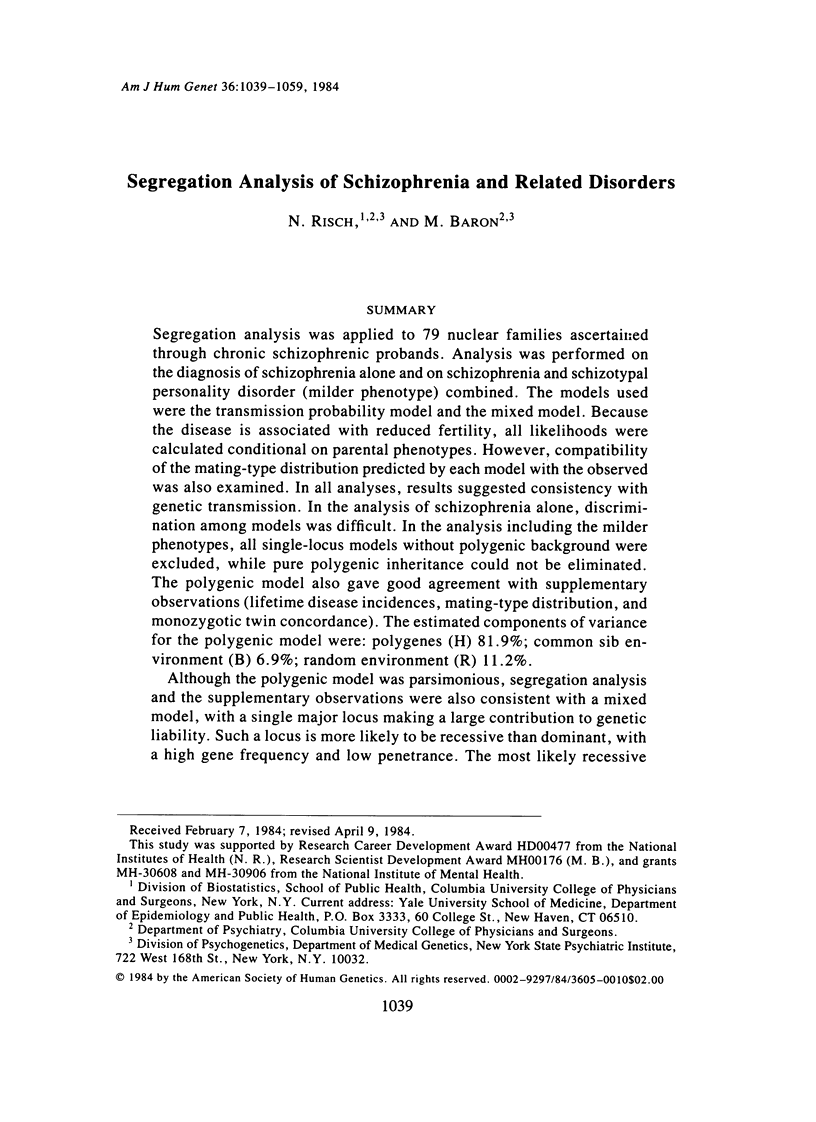
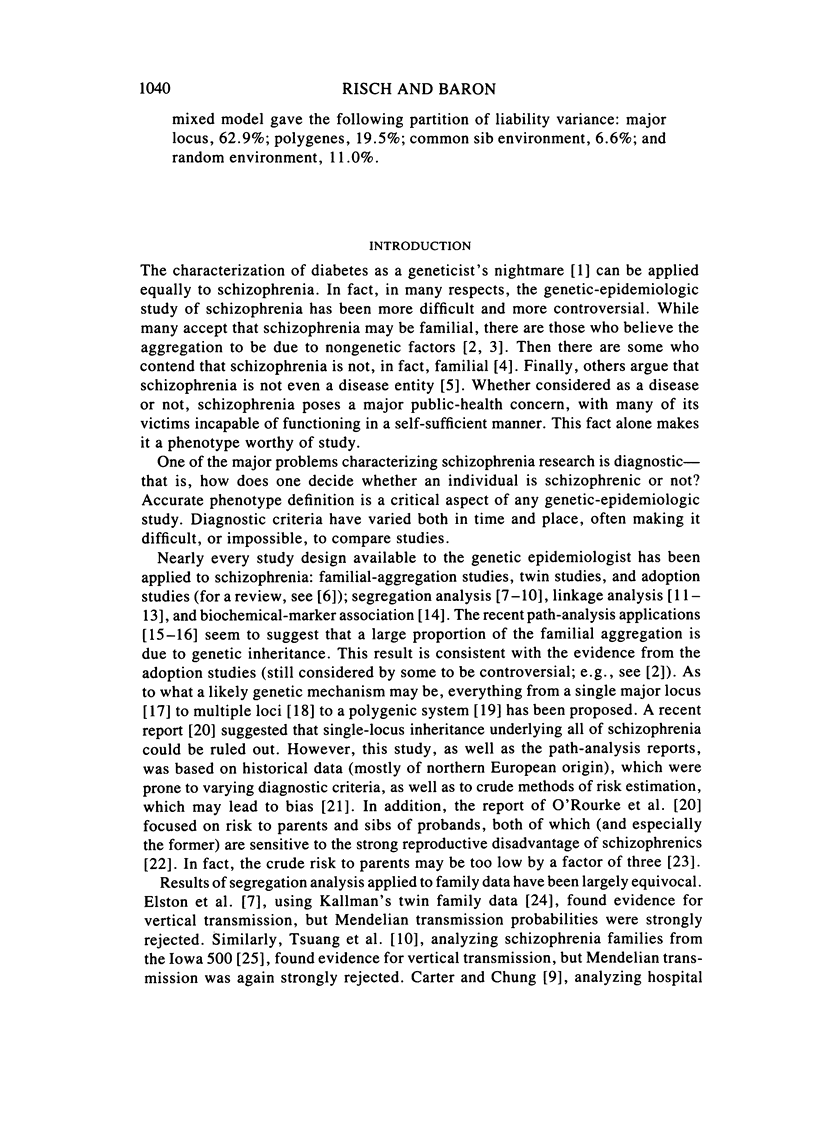
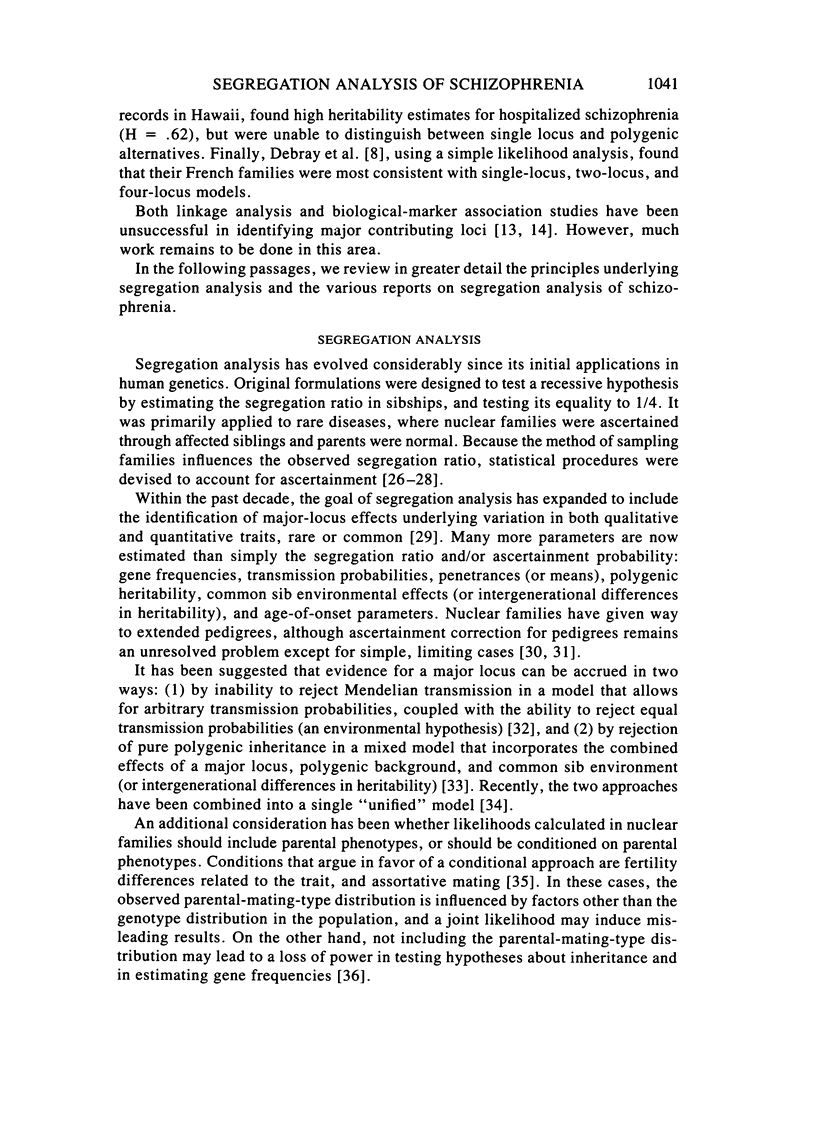
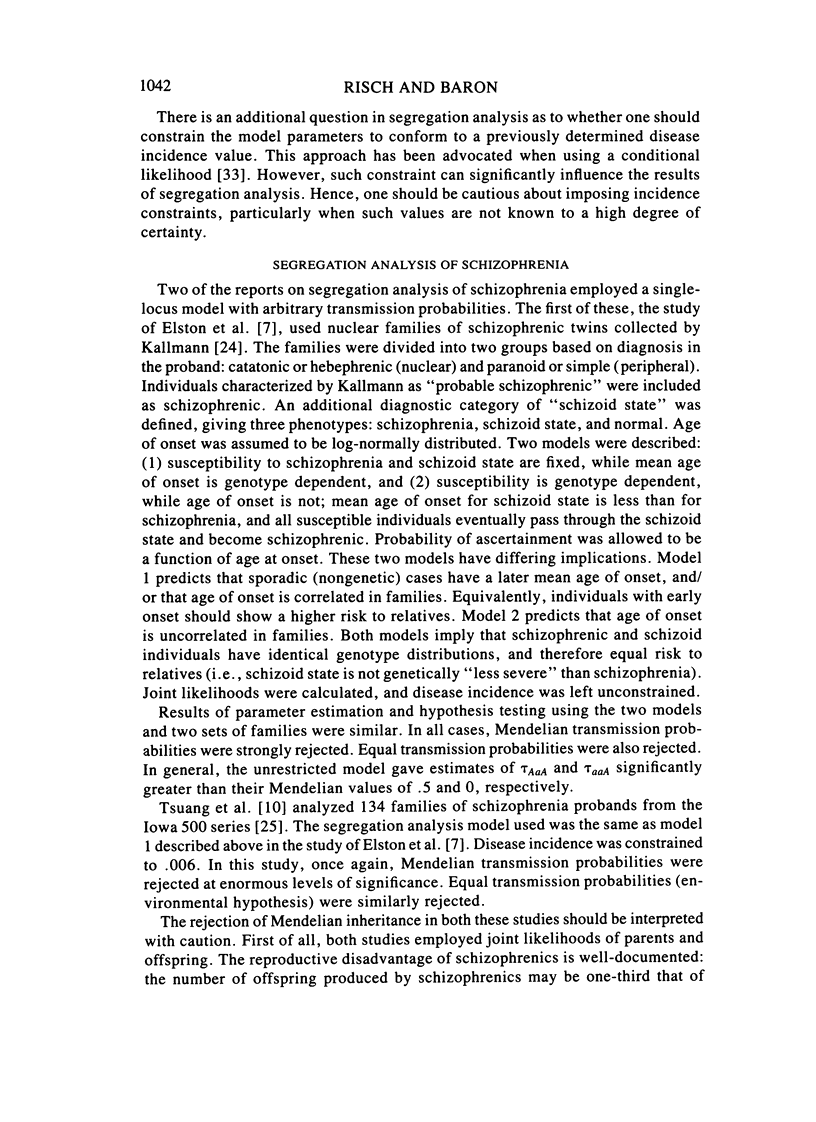
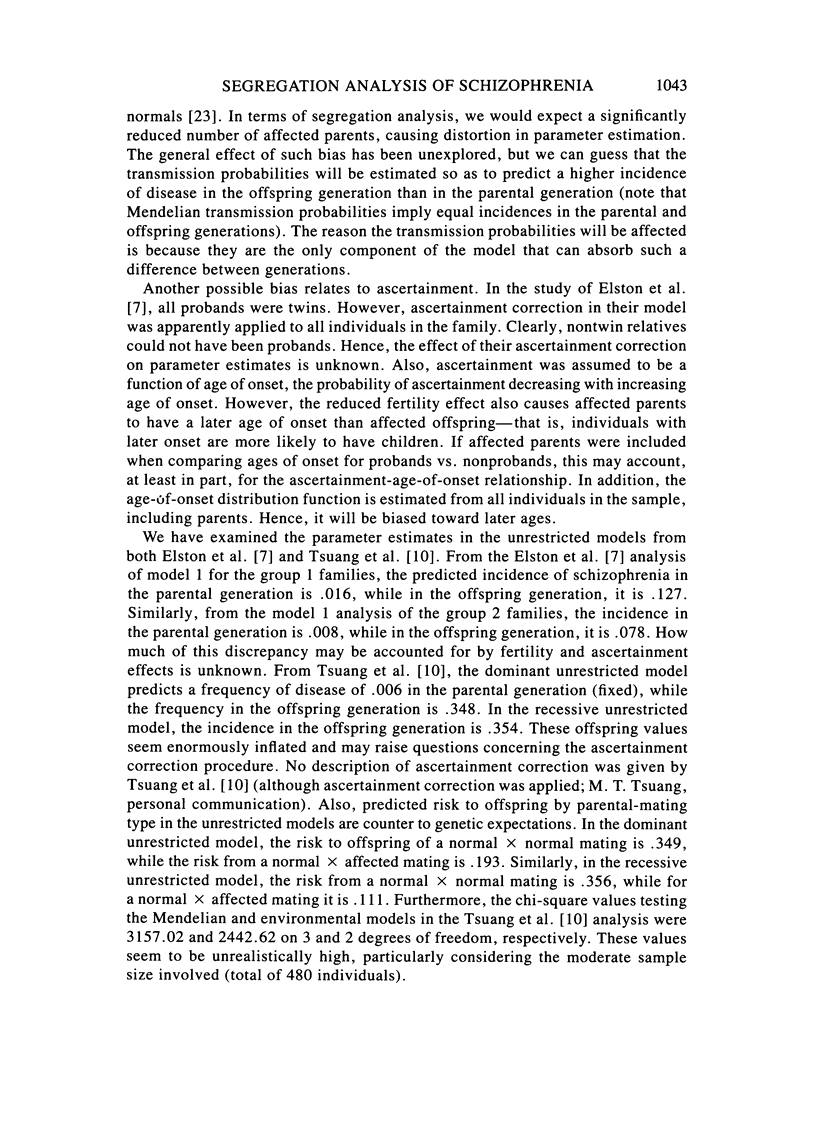
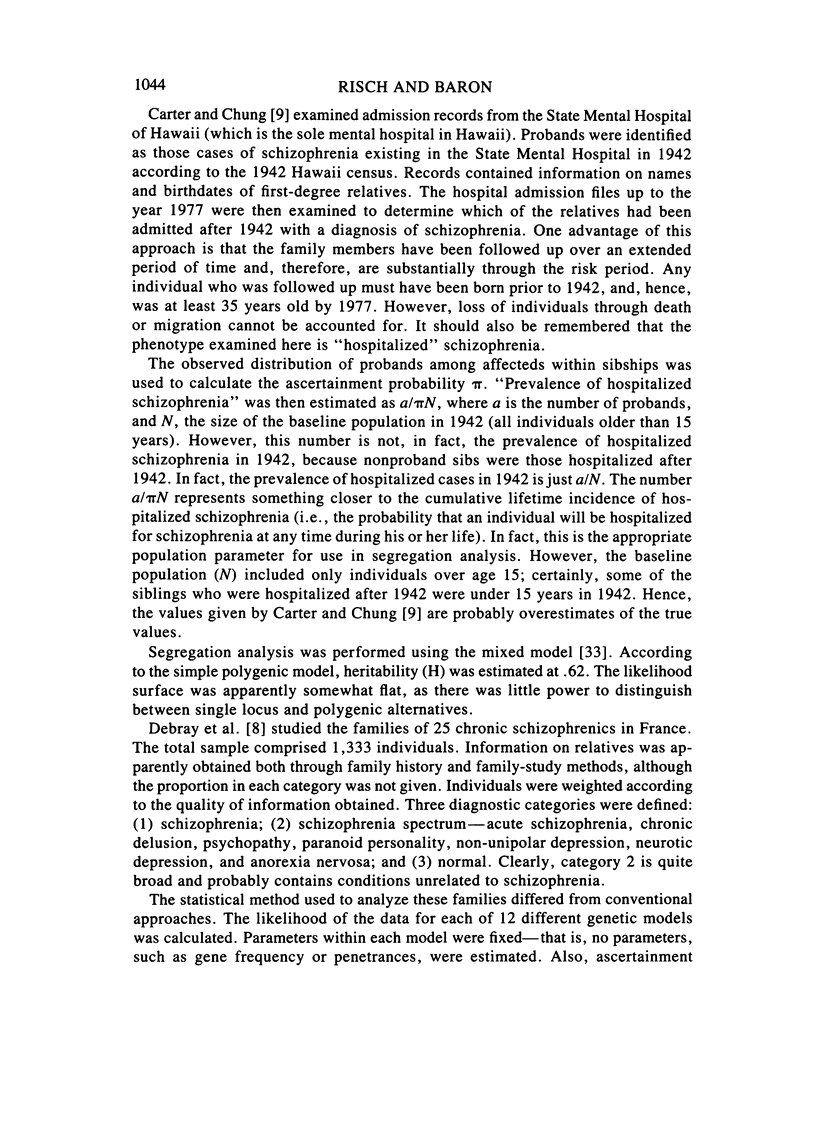
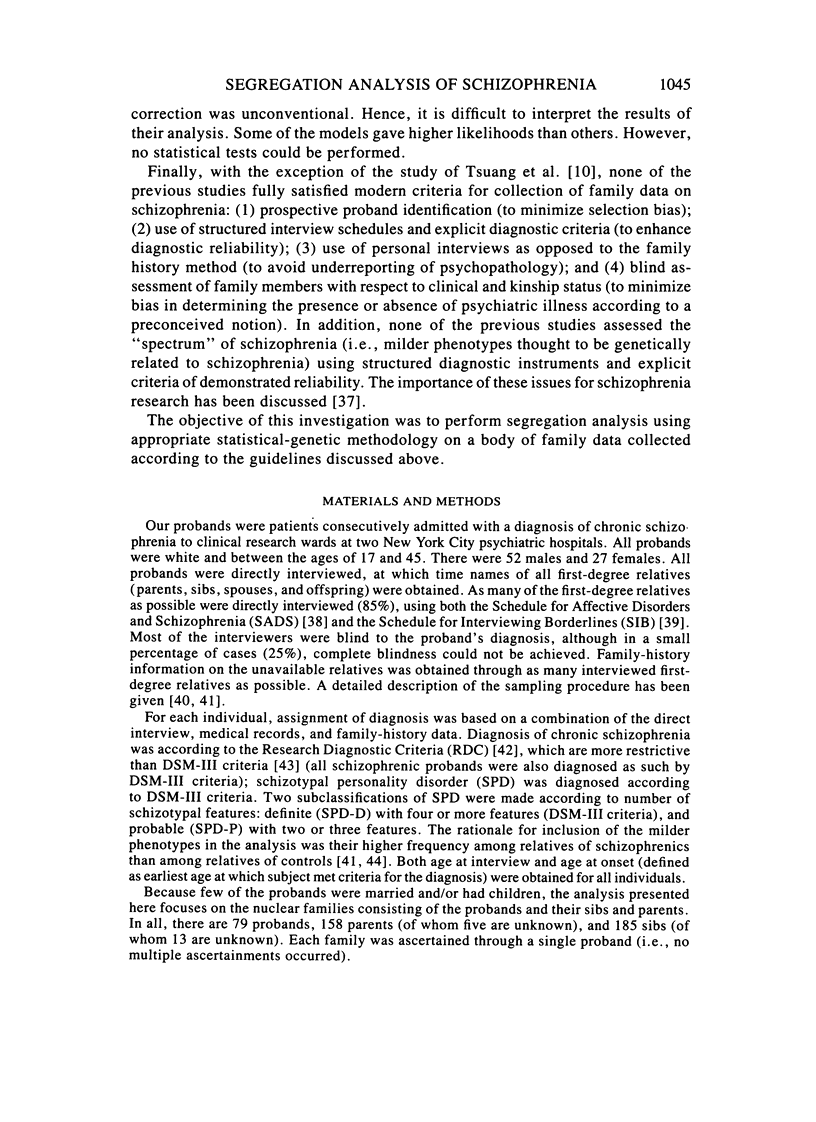
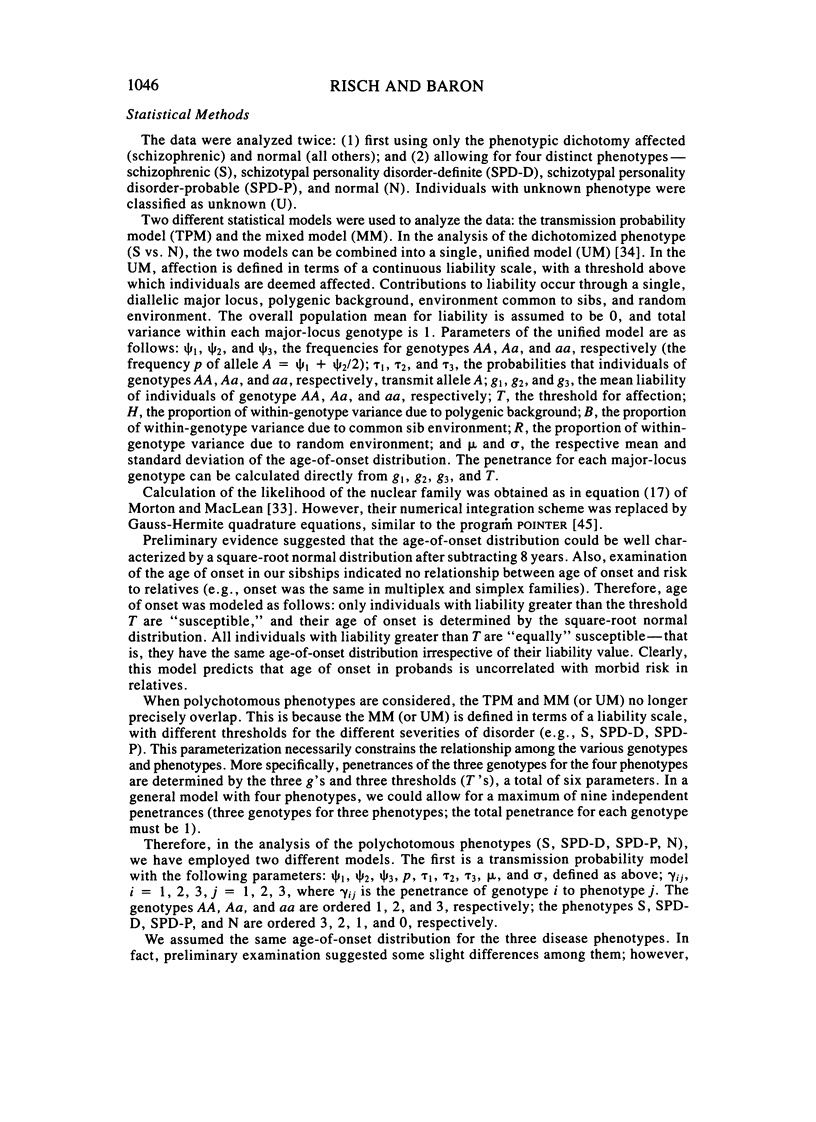

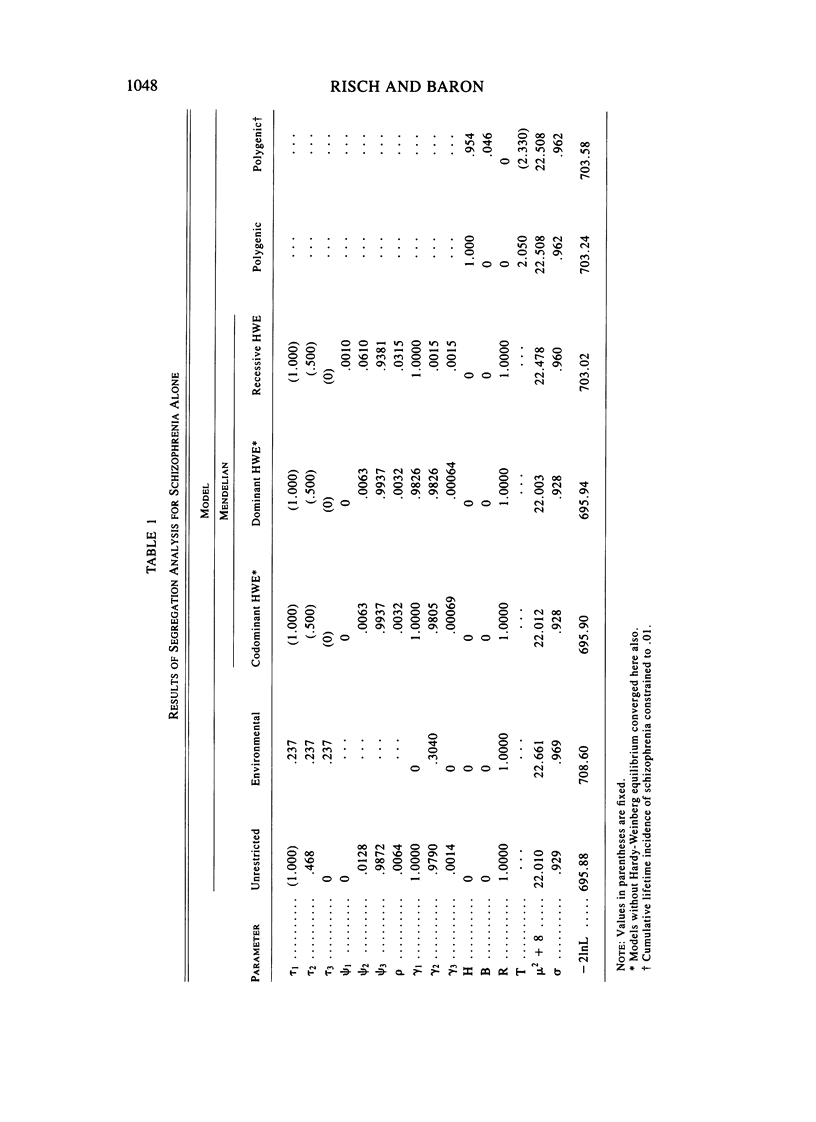
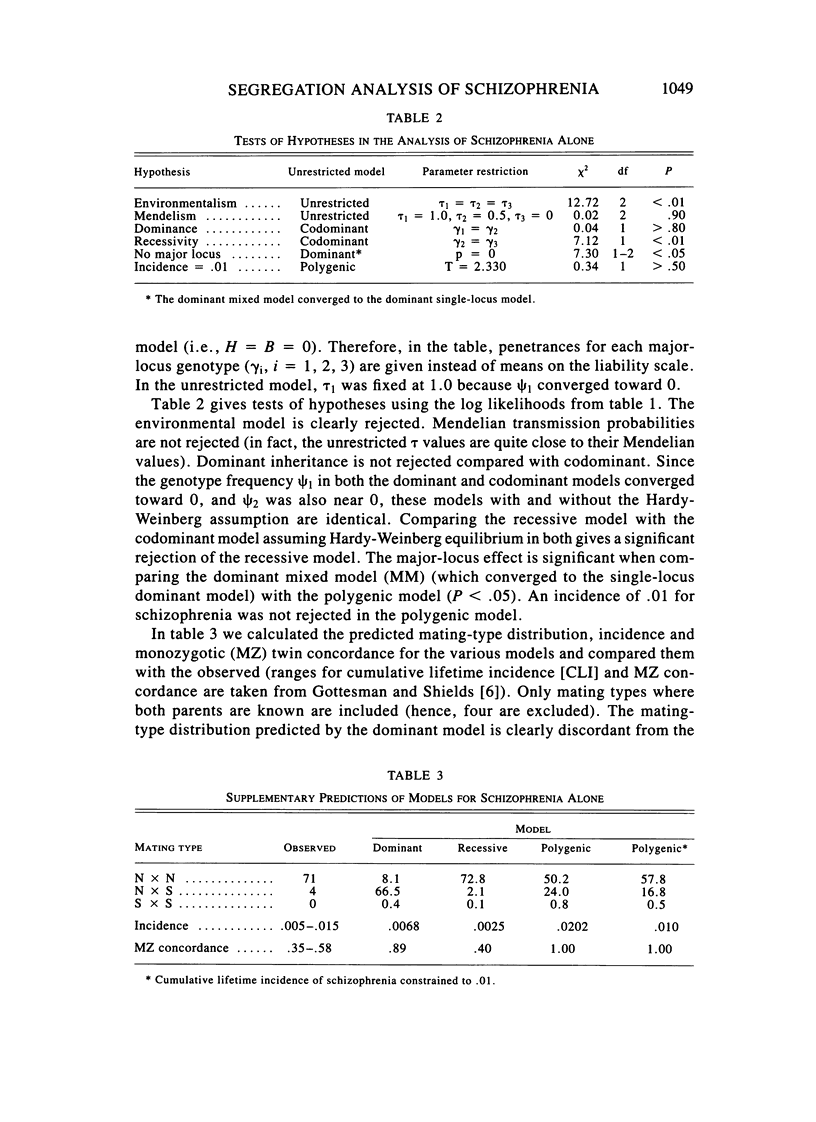
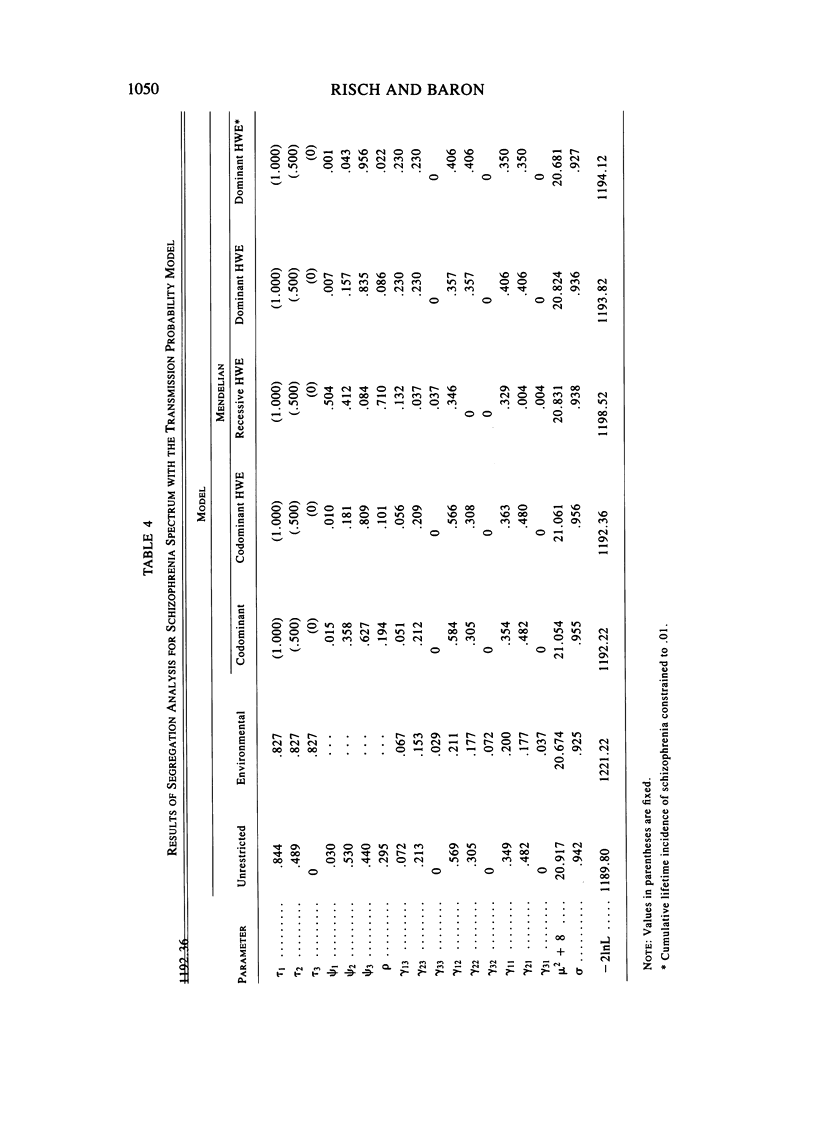
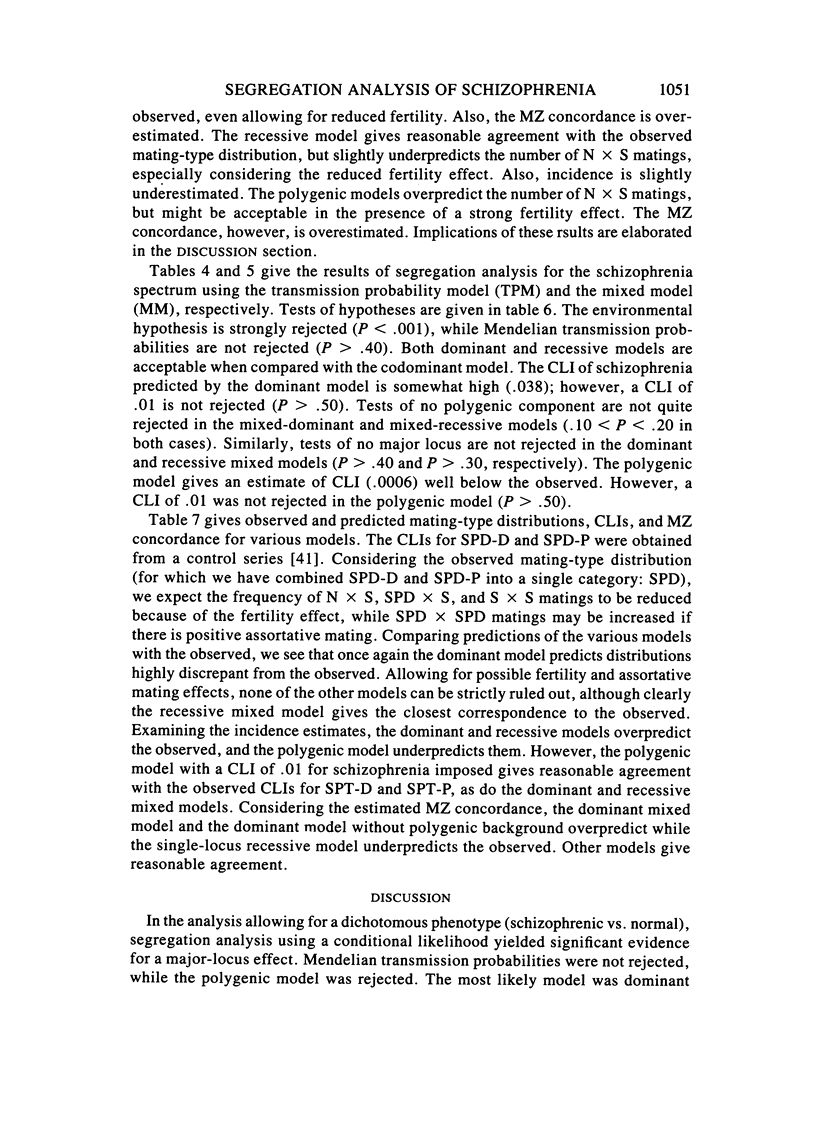
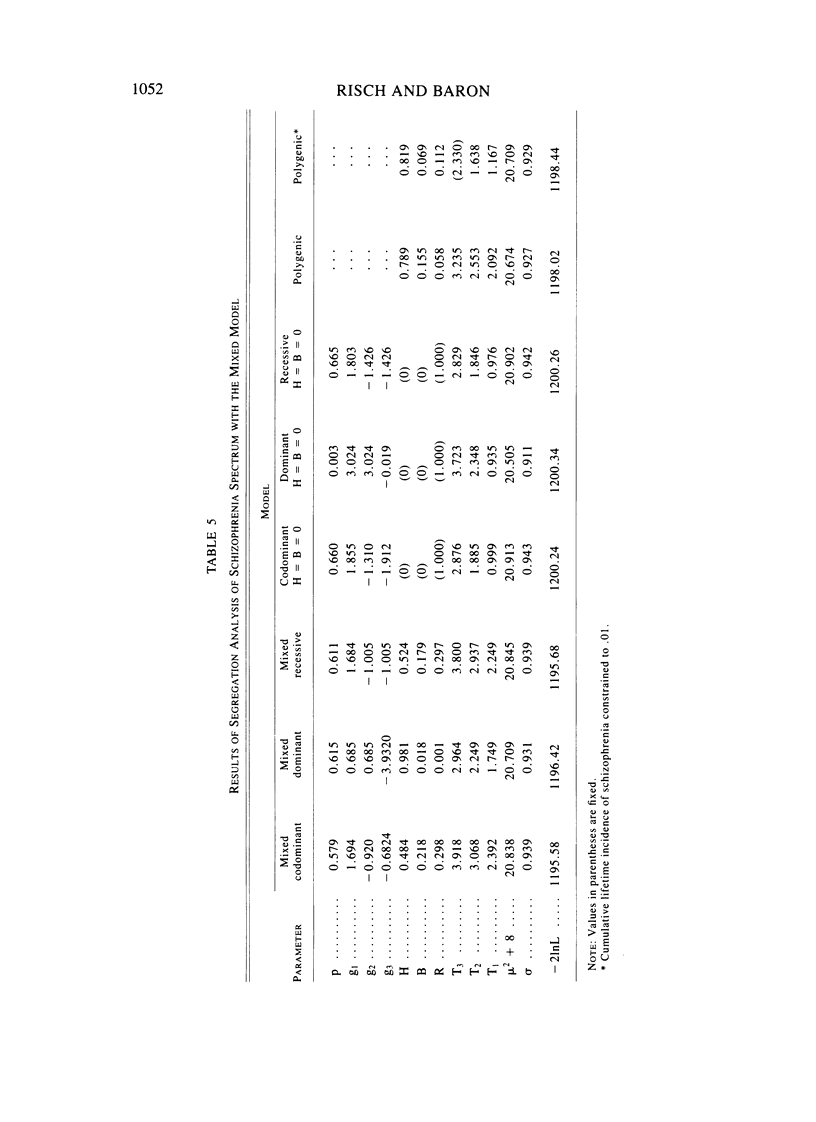
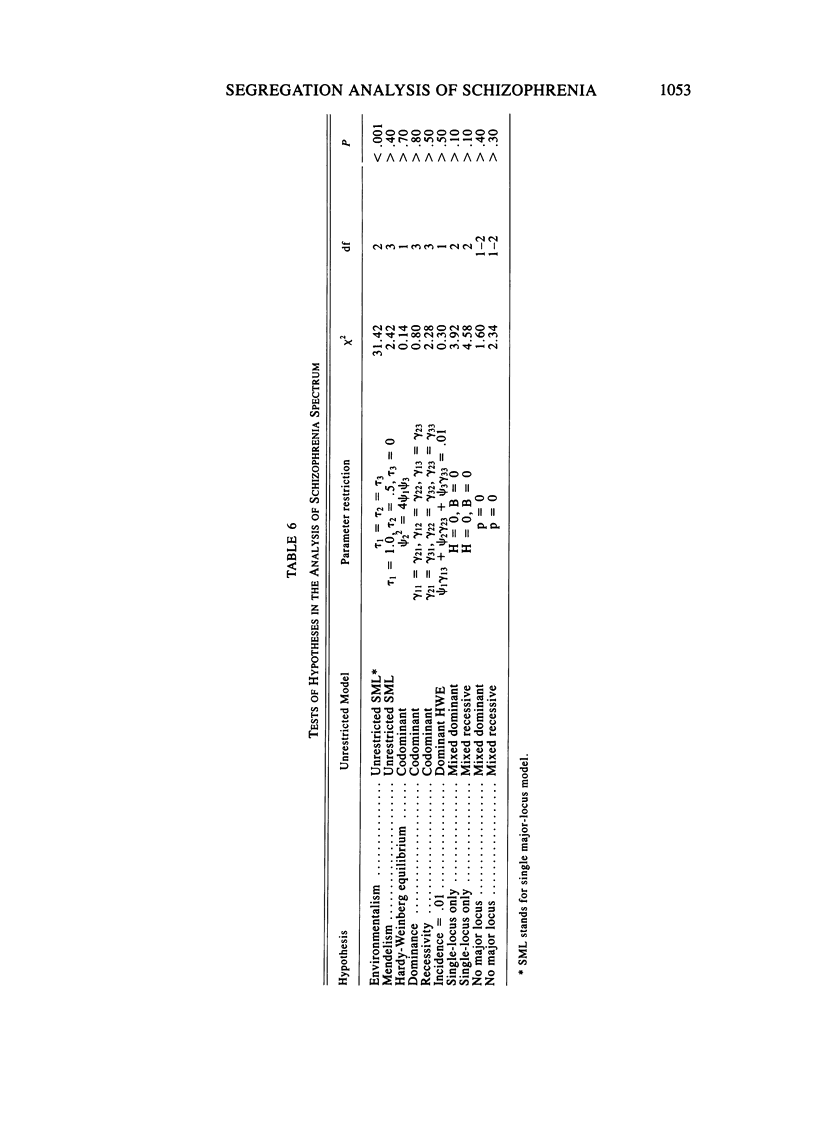
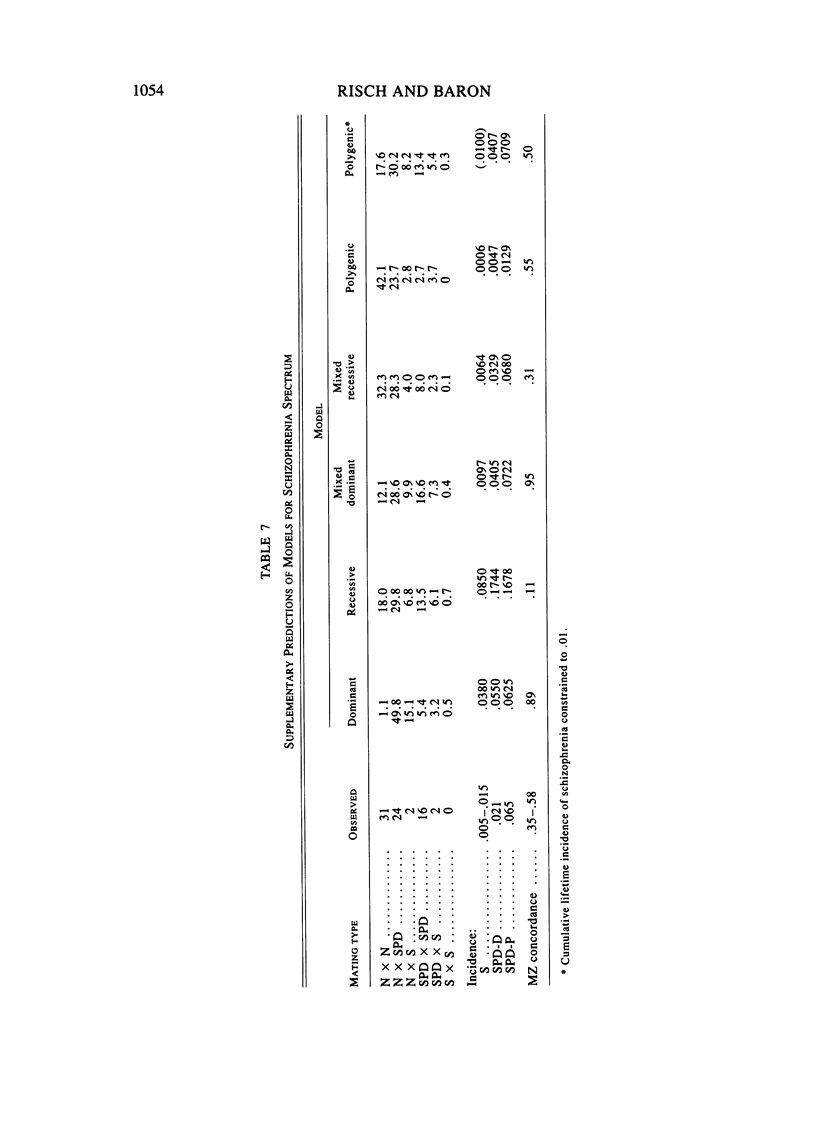
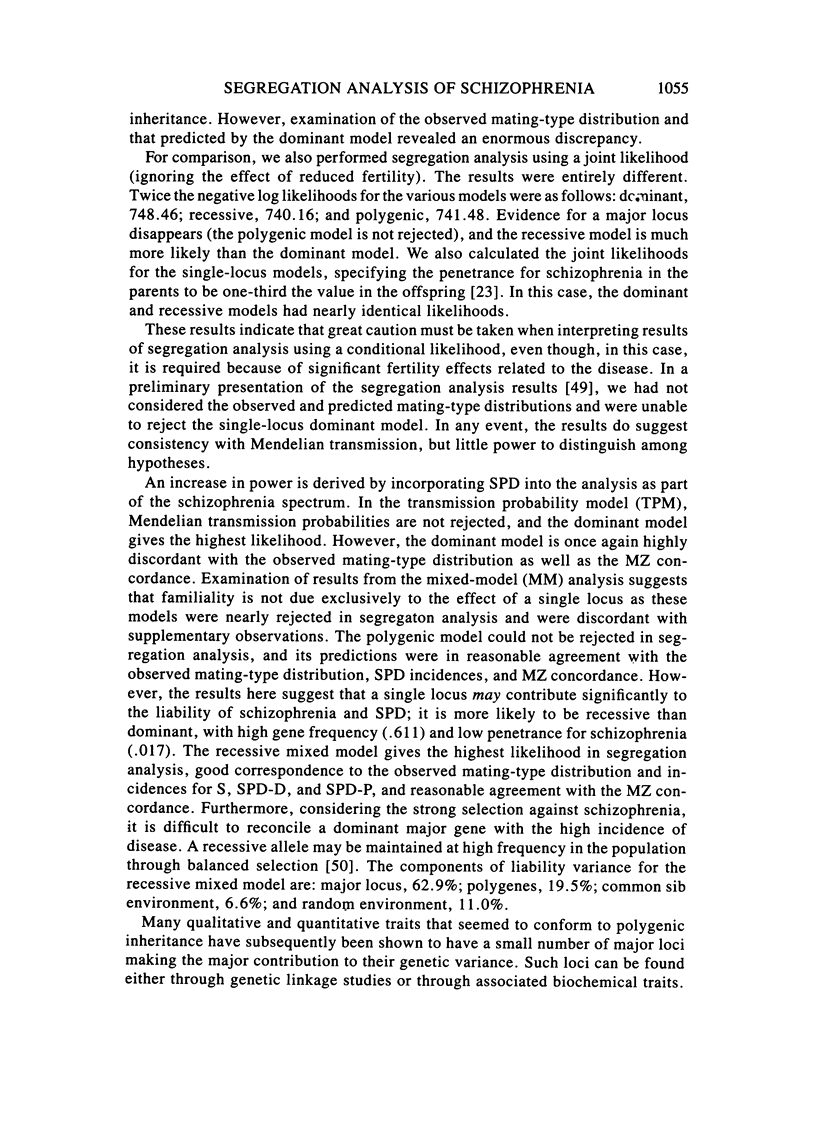
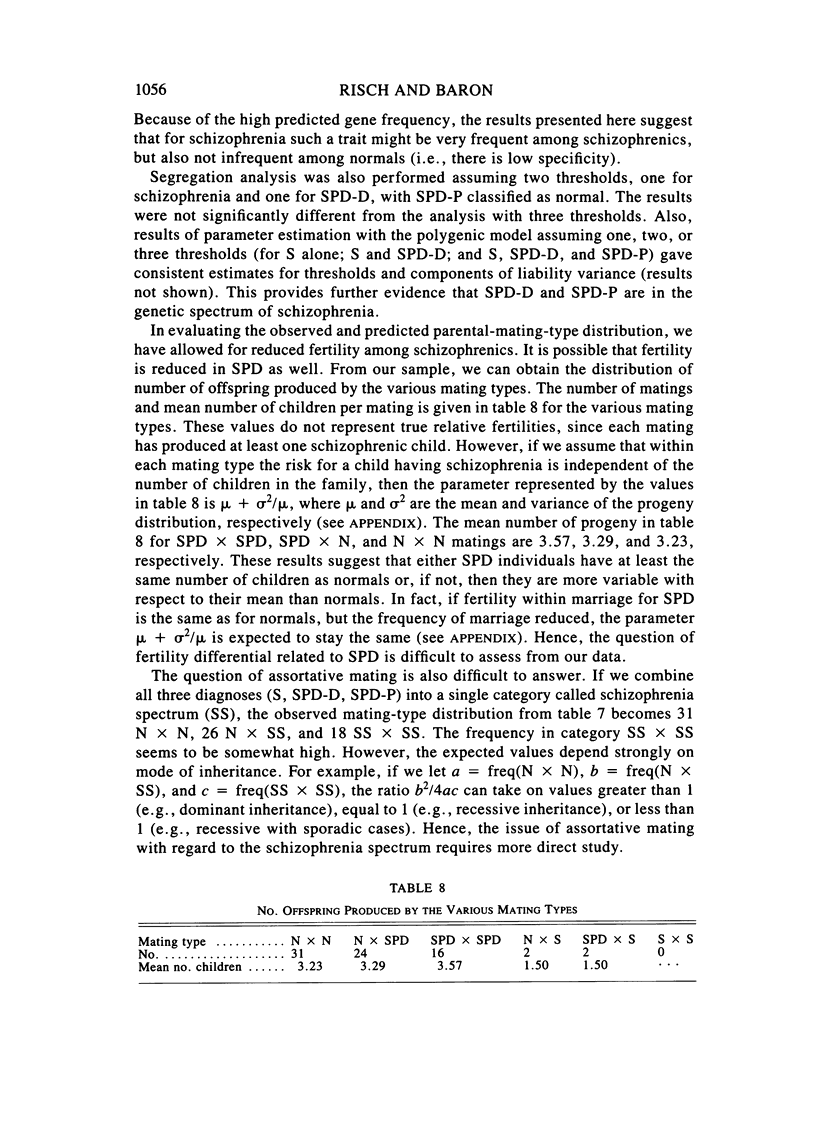
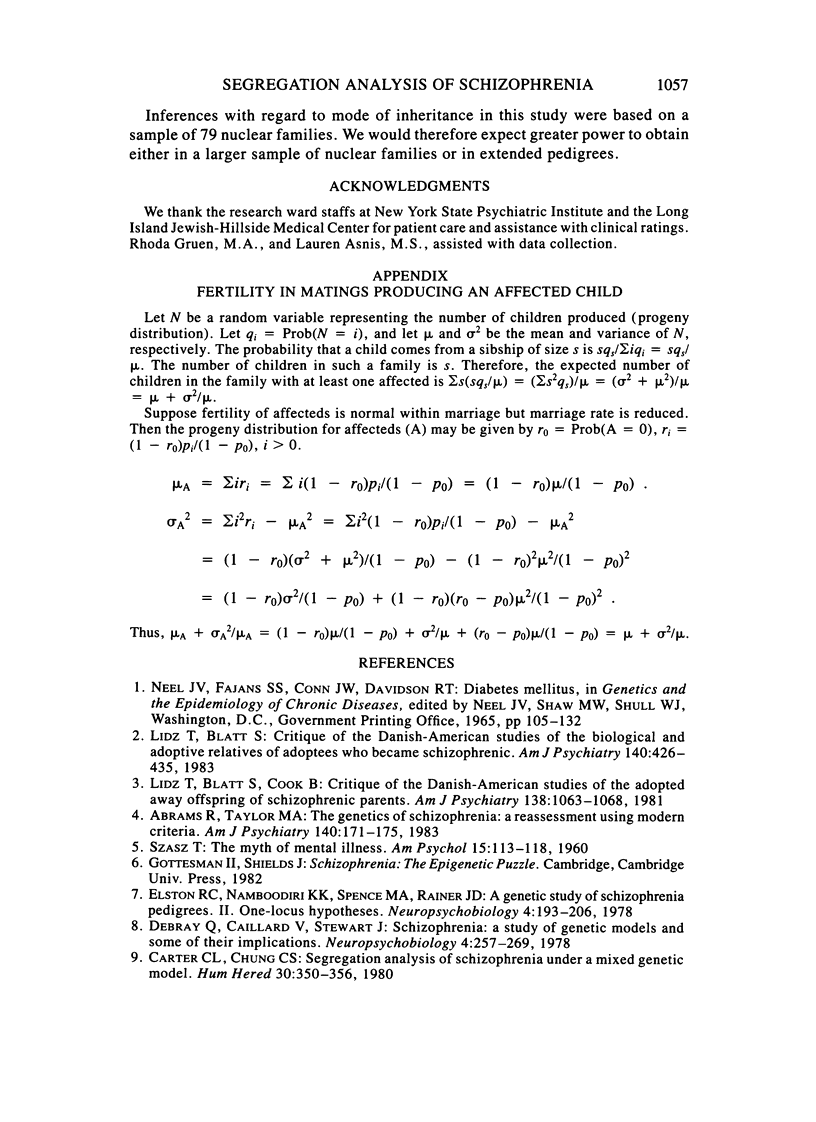
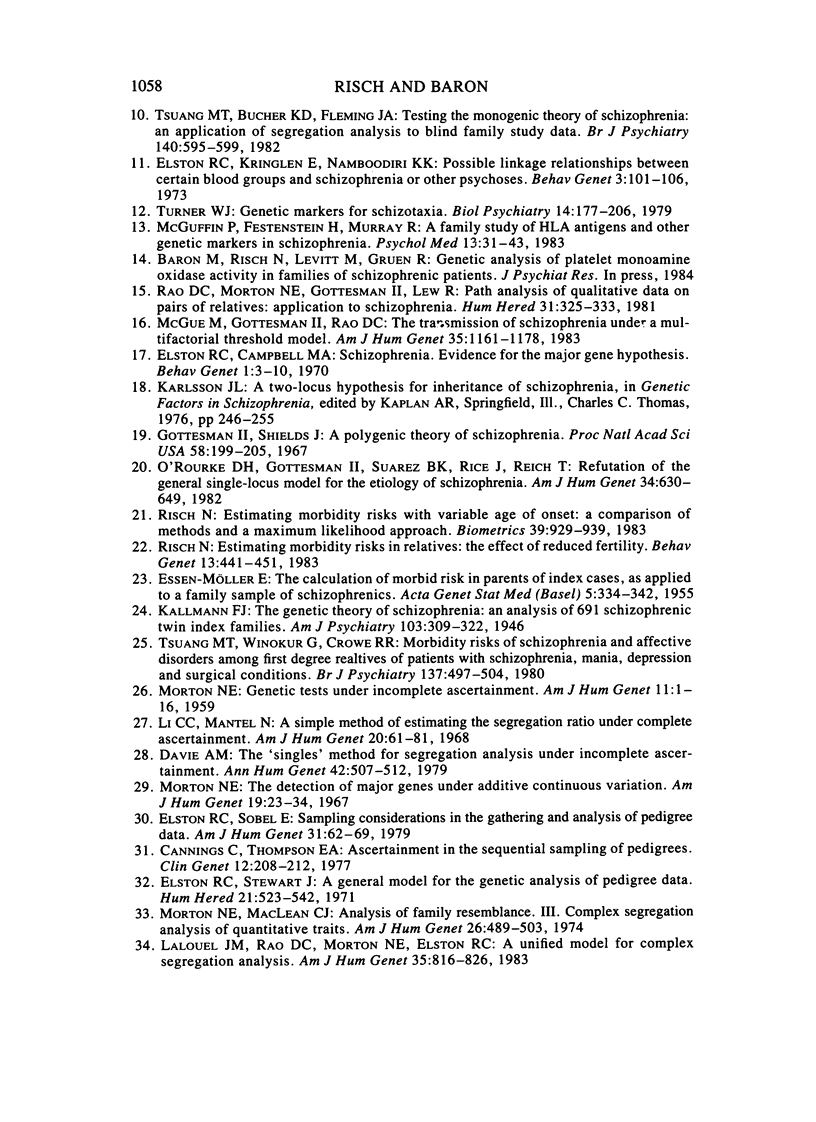
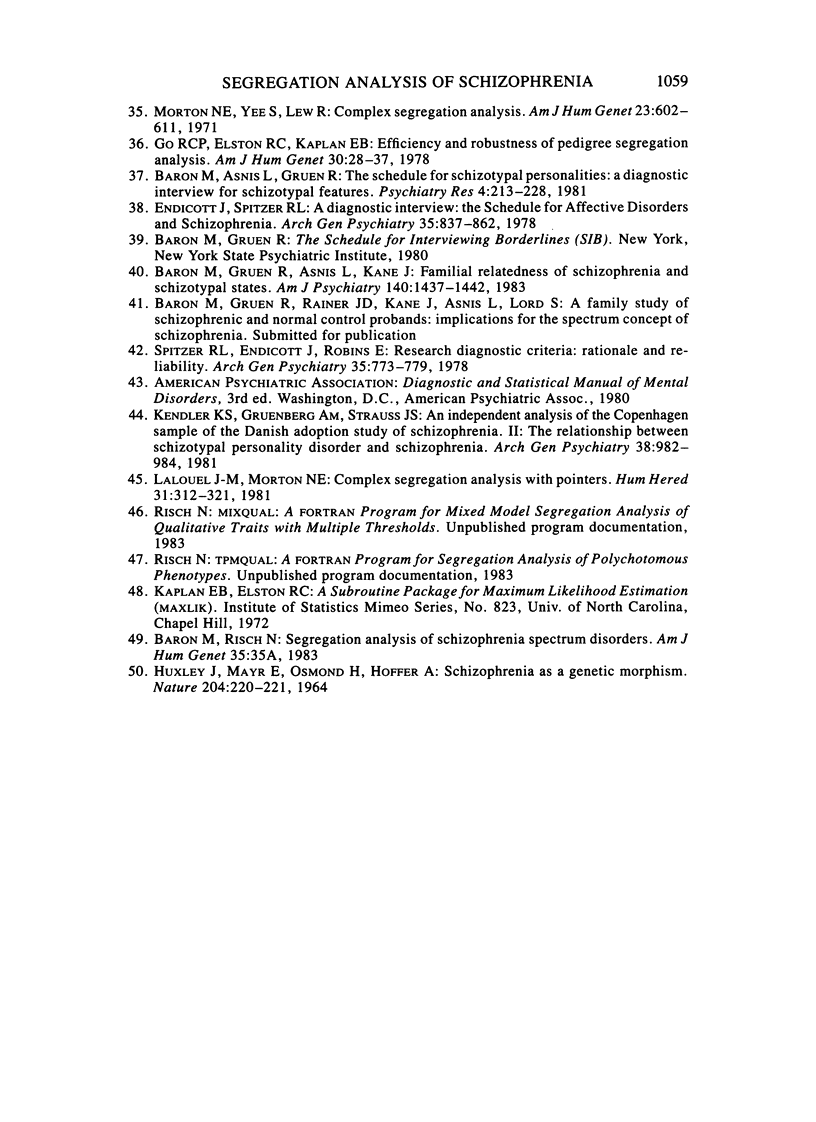
Selected References
These references are in PubMed. This may not be the complete list of references from this article.
- Abrams R., Taylor M. A. The genetics of schizophrenia: a reassessment using modern criteria. Am J Psychiatry. 1983 Feb;140(2):171–175. doi: 10.1176/ajp.140.2.171. [DOI] [PubMed] [Google Scholar]
- Baron M., Asnis L., Gruen R. The schedule for Schizotypal Personalities (SSP): a diagnostic interview for schizotypal features. Psychiatry Res. 1981 Apr;4(2):213–228. doi: 10.1016/0165-1781(81)90024-x. [DOI] [PubMed] [Google Scholar]
- Baron M., Gruen R., Asnis L., Kane J. Familial relatedness of schizophrenia and schizotypal states. Am J Psychiatry. 1983 Nov;140(11):1437–1442. doi: 10.1176/ajp.140.11.1437. [DOI] [PubMed] [Google Scholar]
- Cannings C., Thompson E. A. Ascertainment in the sequential sampling of pedigrees. Clin Genet. 1977 Oct;12(4):208–212. doi: 10.1111/j.1399-0004.1977.tb00928.x. [DOI] [PubMed] [Google Scholar]
- Carter C. L., Chung C. S. Segregation analysis of schizophrenia under a mixed genetic model. Hum Hered. 1980;30(6):350–356. doi: 10.1159/000153156. [DOI] [PubMed] [Google Scholar]
- Davie A. M. The 'singles' method for segregation analysis under incomplete ascertainment. Ann Hum Genet. 1979 May;42(4):507–512. doi: 10.1111/j.1469-1809.1979.tb00683.x. [DOI] [PubMed] [Google Scholar]
- Debray Q., Caillard V., Stewart J. Schizophrenia: a study of genetic models and some of their implications. Neuropsychobiology. 1978;4(5):257–269. doi: 10.1159/000117639. [DOI] [PubMed] [Google Scholar]
- ESSEN-MOLLER E. The calculation of morbid risk in parents of index cases, as applied to a family sample of schizophrenics. Acta Genet Stat Med. 1955;5(4):334–342. doi: 10.1159/000150781. [DOI] [PubMed] [Google Scholar]
- Elston R. C., Campbell M. A. Schizophrenia: evidence for the major gene hypothesis. Behav Genet. 1970 Feb;1(1):3–10. doi: 10.1007/BF01067366. [DOI] [PubMed] [Google Scholar]
- Elston R. C., Kringlen E., Namboodiri K. K. Possible linkage relationships between certain blood groups and schizophrenia or other psychoses. Behav Genet. 1973 Jun;3(2):101–106. doi: 10.1007/BF01067650. [DOI] [PubMed] [Google Scholar]
- Elston R. C., Namboodiri K. K., Spence M. A., Rainer J. D. A genetic study of schizophrenia pedigrees. II. One-locus hypotheses. Neuropsychobiology. 1978;4(4):193–206. doi: 10.1159/000117633. [DOI] [PubMed] [Google Scholar]
- Elston R. C., Sobel E. Sampling considerations in the gathering and analysis of pedigree data. Am J Hum Genet. 1979 Jan;31(1):62–69. [PMC free article] [PubMed] [Google Scholar]
- Elston R. C., Stewart J. A general model for the genetic analysis of pedigree data. Hum Hered. 1971;21(6):523–542. doi: 10.1159/000152448. [DOI] [PubMed] [Google Scholar]
- Endicott J., Spitzer R. L. A diagnostic interview: the schedule for affective disorders and schizophrenia. Arch Gen Psychiatry. 1978 Jul;35(7):837–844. doi: 10.1001/archpsyc.1978.01770310043002. [DOI] [PubMed] [Google Scholar]
- Go R. C., Elston R. C., Kaplan E. B. Efficiency and robustness of pedigree segregation analysis. Am J Hum Genet. 1978 Jan;30(1):28–37. [PMC free article] [PubMed] [Google Scholar]
- Gottesman I. I., Shields J. A polygenic theory of schizophrenia. Proc Natl Acad Sci U S A. 1967 Jul;58(1):199–205. doi: 10.1073/pnas.58.1.199. [DOI] [PMC free article] [PubMed] [Google Scholar]
- HUXLEY J., MAYR E., OSMOND H., HOFFER A. SCHIZOPHRENIA AS A GENETIC MORPHISM. Nature. 1964 Oct 17;204:220–221. doi: 10.1038/204220a0. [DOI] [PubMed] [Google Scholar]
- Kendler K. S., Gruenberg A. M., Strauss J. S. An independent analysis of the Copenhagen sample of the Danish adoption study of schizophrenia. II. The relationship between schizotypal personality disorder and schizophrenia. Arch Gen Psychiatry. 1981 Sep;38(9):982–984. doi: 10.1001/archpsyc.1981.01780340034003. [DOI] [PubMed] [Google Scholar]
- Lalouel J. M., Morton N. E. Complex segregation analysis with pointers. Hum Hered. 1981;31(5):312–321. doi: 10.1159/000153231. [DOI] [PubMed] [Google Scholar]
- Lalouel J. M., Rao D. C., Morton N. E., Elston R. C. A unified model for complex segregation analysis. Am J Hum Genet. 1983 Sep;35(5):816–826. [PMC free article] [PubMed] [Google Scholar]
- Li C. C., Mantel N. A simple method of estimating the segregation ratio under complete ascertainment. Am J Hum Genet. 1968 Jan;20(1):61–81. [PMC free article] [PubMed] [Google Scholar]
- Lidz T., Blatt S., Cook B. Critique of the Danish-American studies of the adopted-away offspring of schizophrenic parents. Am J Psychiatry. 1981 Aug;138(8):1063–1068. doi: 10.1176/ajp.138.8.1063. [DOI] [PubMed] [Google Scholar]
- Lidz T., Blatt S. Critique of the Danish-American studies of the biological and adoptive relatives of adoptees who became schizophrenic. Am J Psychiatry. 1983 Apr;140(4):426–434. doi: 10.1176/ajp.140.4.426. [DOI] [PubMed] [Google Scholar]
- MORTON N. E. Genetic tests under incomplete ascertainment. Am J Hum Genet. 1959 Mar;11(1):1–16. [PMC free article] [PubMed] [Google Scholar]
- McGue M., Gottesman I. I., Rao D. C. The transmission of schizophrenia under a multifactorial threshold model. Am J Hum Genet. 1983 Nov;35(6):1161–1178. [PMC free article] [PubMed] [Google Scholar]
- McGuffin P., Festenstein H., Murray R. A family study of HLA antigens and other genetic markers in schizophrenia. Psychol Med. 1983 Feb;13(1):31–43. doi: 10.1017/s0033291700050042. [DOI] [PubMed] [Google Scholar]
- Morton N. E., MacLean C. J. Analysis of family resemblance. 3. Complex segregation of quantitative traits. Am J Hum Genet. 1974 Jul;26(4):489–503. [PMC free article] [PubMed] [Google Scholar]
- Morton N. E. The detection of major genes under additive continuous variation. Am J Hum Genet. 1967 Jan;19(1):23–34. [PMC free article] [PubMed] [Google Scholar]
- Morton N. E., Yee S., Lew R. Complex segregation analysis. Am J Hum Genet. 1971 Nov;23(6):602–611. [PMC free article] [PubMed] [Google Scholar]
- O'Rourke D. H., Gottesman I. I., Suarez B. K., Rice J., Reich T. Refutation of the general single-locus model for the etiology of schizophrenia. Am J Hum Genet. 1982 Jul;34(4):630–649. [PMC free article] [PubMed] [Google Scholar]
- Rao D. C., Morton N. E., Gottesman I. I., Lew R. Path analysis of qualitative data on pairs of relatives: application to schizophrenia. Hum Hered. 1981;31(6):325–333. doi: 10.1159/000153233. [DOI] [PubMed] [Google Scholar]
- Risch N. Estimating morbidity risks in relatives: the effect of reduced fertility. Behav Genet. 1983 Sep;13(5):441–451. doi: 10.1007/BF01065920. [DOI] [PubMed] [Google Scholar]
- Risch N. Estimating morbidity risks with variable age of onset: review of methods and a maximum likelihood approach. Biometrics. 1983 Dec;39(4):929–939. [PubMed] [Google Scholar]
- Spitzer R. L., Endicott J., Robins E. Research diagnostic criteria: rationale and reliability. Arch Gen Psychiatry. 1978 Jun;35(6):773–782. doi: 10.1001/archpsyc.1978.01770300115013. [DOI] [PubMed] [Google Scholar]
- Tsuang M. T., Bucher K. D., Fleming J. A. Testing the monogenic theory of schizophrenia: An application of segregation analysis to blind family study data. Br J Psychiatry. 1982 Jun;140:595–599. doi: 10.1192/bjp.140.6.595. [DOI] [PubMed] [Google Scholar]
- Tsuang M. T., Winokur G., Crowe R. R. Morbidity risks of schizophrenia and affective disorders among first degree relatives of patients with schizophrenia, mania, depression and surgical conditions. Br J Psychiatry. 1980 Dec;137:497–504. doi: 10.1192/bjp.137.6.497. [DOI] [PubMed] [Google Scholar]
- Turner W. J. Genetic markers for schizotaxia. Biol Psychiatry. 1979 Feb;14(1):177–206. [PubMed] [Google Scholar]


